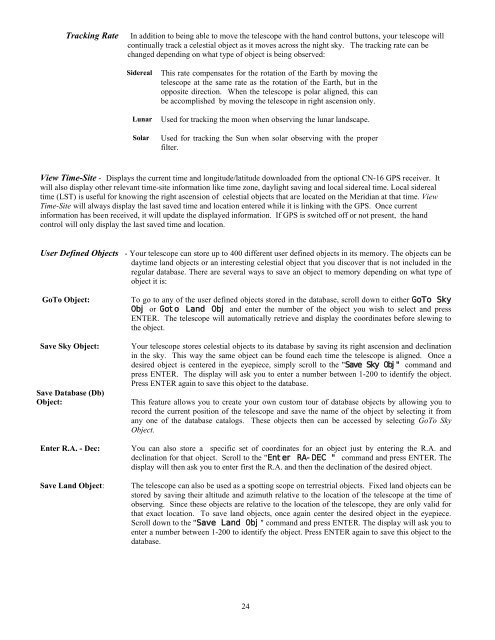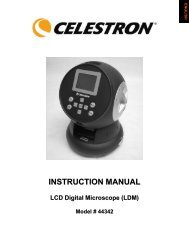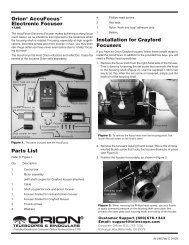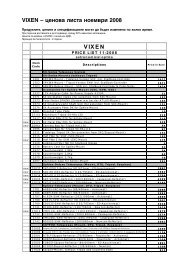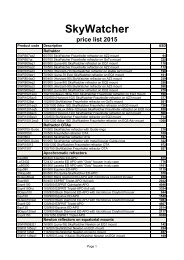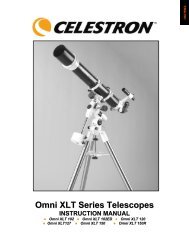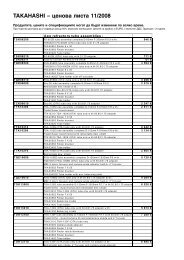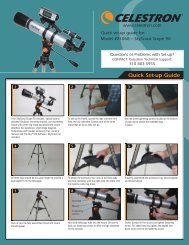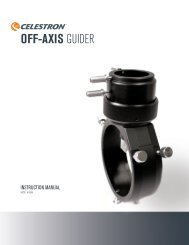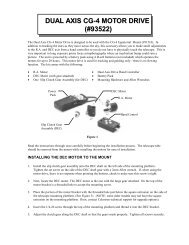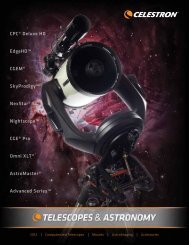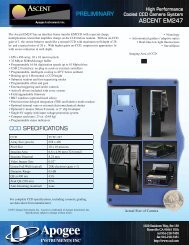You also want an ePaper? Increase the reach of your titles
YUMPU automatically turns print PDFs into web optimized ePapers that Google loves.
Tracking RateIn addition to being able to move the telescope with the hand control buttons, your telescope willcontinually track a celestial object as it moves across the night sky. The tracking rate can bechanged depending on what type of object is being observed:SiderealLunarSolarThis rate compensates for the rotation of the Earth by moving thetelescope at the same rate as the rotation of the Earth, but in theopposite direction. When the telescope is polar aligned, this canbe accomplished by moving the telescope in right ascension only.Used for tracking the moon when observing the lunar landscape.Used for tracking the Sun when solar observing with the properfilter.View Time-Site - Displays the current time and longitude/latitude downloaded from the optional CN-16 GPS receiver. Itwill also display other relevant time-site information like time zone, daylight saving and local sidereal time. Local siderealtime (LST) is useful for knowing the right ascension of celestial objects that are located on the Meridian at that time. ViewTime-Site will always display the last saved time and location entered while it is linking with the GPS. Once currentinformation has been received, it will update the displayed information. If GPS is switched off or not present, the handcontrol will only display the last saved time and location.User Defined Objects - Your telescope can store up to 400 different user defined objects in its memory. The objects can bedaytime land objects or an interesting celestial object that you discover that is not included in theregular database. There are several ways to save an object to memory depending on what type ofobject it is:GoTo Object:Save Sky Object:Save Database (Db)Object:Enter R.A. - Dec:Save Land Object:To go to any of the user defined objects stored in the database, scroll down to either GoTo SkyObj or Goto Land Obj and enter the number of the object you wish to select and pressENTER. The telescope will automatically retrieve and display the coordinates before slewing tothe object.Your telescope stores celestial objects to its database by saving its right ascension and declinationin the sky. This way the same object can be found each time the telescope is aligned. Once adesired object is centered in the eyepiece, simply scroll to the "Save Sky Obj" command andpress ENTER. The display will ask you to enter a number between 1-200 to identify the object.Press ENTER again to save this object to the database.This feature allows you to create your own custom tour of database objects by allowing you torecord the current position of the telescope and save the name of the object by selecting it fromany one of the database catalogs. These objects then can be accessed by selecting GoTo SkyObject.You can also store a specific set of coordinates for an object just by entering the R.A. anddeclination for that object. Scroll to the "Enter RA-DEC " command and press ENTER. Thedisplay will then ask you to enter first the R.A. and then the declination of the desired object.The telescope can also be used as a spotting scope on terrestrial objects. Fixed land objects can bestored by saving their altitude and azimuth relative to the location of the telescope at the time ofobserving. Since these objects are relative to the location of the telescope, they are only valid forthat exact location. To save land objects, once again center the desired object in the eyepiece.Scroll down to the "Save Land Obj" command and press ENTER. The display will ask you toenter a number between 1-200 to identify the object. Press ENTER again to save this object to thedatabase.24


